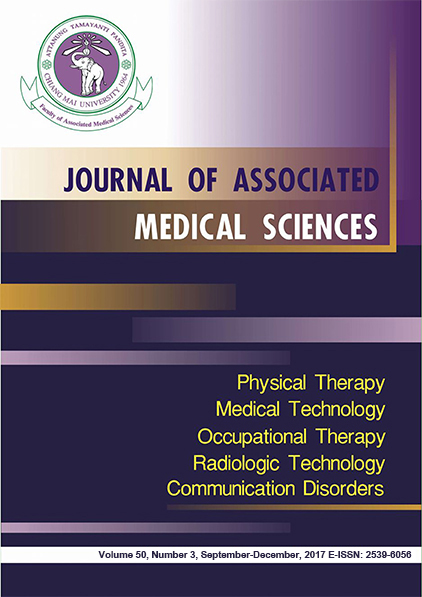Reliability and validity of adapted gravitational goniometer and hand-held inclinometer in measuring shoulder mobility
Main Article Content
Abstract
Background: Goniometer is a physical therapy tool for evaluation of the range of motion. Standard goniometer is commonly used in clinical practice. However, simple and inexpensive tools are necessary for community based practice.
Objectives: To study reliability and validity between adapted gravitational goniometer (AGG) and hand-held inclinometer (HHI) in measuring shoulder range of motion.
Materials and methods: One hundred and eight female subjects aged between 18-22 years old (19.25±0.99 years old) without shoulder operation or injuries of shoulder, clavicle, scapular, and shoulder muscle recruited for this study. All subjects were evaluated for the ranges of motion of shoulder flexion, extension, abduction, and adduction by AGG and HHI.
Results: Mean average of shoulder flexion measured by AGG (167.69±6.3 degrees) and by HHI (167.78±7.23 degrees) was significant correlated at r=0.84 (p<0.05). Mean average of shoulder extension measured by AGG (36.29±10.84 degrees) and by HHI (35.19±11.14 degrees) was significant correlated at r=0.67 (p<0.05). Mean average of shoulder abduction measured by AGG (169.44±7.28 degrees) and by HHI (168.48±7.66 degrees) was significant correlated at r=0.78 (p<0.05). Mean average of shoulder adduction measured by AGG (49.05±7.89 degrees) and by HHI (48.08±8.35 degrees) was significant correlated at r=0.66 (p<0.05). The validity study of AGG and HHI revealed by having no significant differences of average ranges of shoulder flexion, shoulder extension, shoulder abduction, and shoulder adduction (p>0.05) measured by two devices.
Conclusion: Adapted gravitational goniometer is reliable and valid in comparison to hand-held inclinometer for evaluation of shoulder flexion, shoulder extension, shoulder adduction, and shoulder abduction.
Article Details
Personal views expressed by the contributors in their articles are not necessarily those of the Journal of Associated Medical Sciences, Faculty of Associated Medical Sciences, Chiang Mai University.
References
2. Clarkson HM. Musculoskeletal assessment. Joint range of motion and manual muscle strength. 2nded. Lippincott Williams & Wilkins: Philadelphia; 2000.
3. Reese NB, Bandy WD. Joint range of motion and muscle length testing. 2nd ed. Saunders Elsevier: Canada; 2010.
4. Lea RD, Gerhardt JJ. Range-of-motion measurements. J Bone Joint Surg Am 1995; 77(5): 784-98.
5. Clapis PA, Davis SM, Davis RO. Reliability of inclinometer and goniometric measurements of hip extension flexibility using the modified Thomas test. Physiother Theory Pract 2008; 24(2): 135-41. doi: 10.1080/09593980701378256.
6. Grove SK. Statistics for health care research: a practical workbook. 1st ed. Elsevier Saunders: Edinburgh; 2007.
7. Shieh G. Sample size requirements for the design of reliability studies: precision consideration. Behav Res Methods 2014; 46(3): 808-22. doi: 10.3758/s13428-013-0415-1.
8. Inclinometers. [Internet]. Australia: Australasian Medical & Therapeutic Instrument; 2013 [cited 2017 Aug 10]. Available from: http://www.australasianmedical.com.au/.
9. Nussbaumer S, Leunig M, Glatthorn JF, Stauffacher S, Gerber H, Maffiuletti NA. Validity and test-retest reliability of manual goniometers for measuring passive hip range of motion in femoroacetabular impingement patients.BMC Musculoskelet Disord 2010; 11: 1-11. doi: 10.1186/1471-2474-11-194.
10. Steckler A, McLeroy KR. The importance of external validity.Am J Public Health2011; 98(1): 9-10.
11. McKay D. Handbook of research methods in abnormal and clinical psychology. 1st ed. Sage: Los Angeles; 2008.
12. Yankai A, Manosan P. Reliability of the universal and adapted gravity goniometer in measuring active cervical range of motion in normal healthy subjects. IJABME 2009; 2(1): 49-53.
13. Kolber MJ, Hanney WJ. The reliability and concurrent validity of shoulder mobility measurements using a digital inclinometer and goniometer: a technical report. Int J Sports Phys Ther 2012; 7(3): 306-13.
14. Vairo GL, Duffey ML, Owens BD, Cameron KL. Clinical descriptive measures of shoulder range of motion for a healthy, young and physically active cohort. Sports Med Arthrosc Rehabil Ther Technol 2012; 4: 1-7. doi: 10.1186/1758-2555-4-33.
15. Halder AM, Itoi E, An KN. Anatomy and biomechanics of the shoulder. Orthop Clin North Am 2000; 31(2): 159-76.


